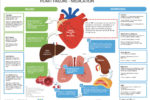We hypothesised that practice heart failure registers may not be complete or robust due to patients not always being allocated the correct READ codes. We set up a project which improved practice heart failure registers. Ensuring practices have robust registers, by improving clinical coding in general practice, means more accurate prevalence levels can inform planning and commissioning of heart failure services.


























